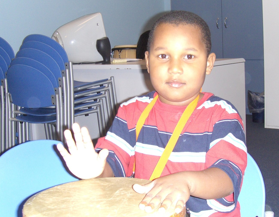Cali Willcockson was an exceptional child destined for exceptional success as an adult when a devastating automobile accident put that future in jeopardy.
Cali suffered a traumatic brain injury in the accident, and her mother suffered severe physical injuries, including a spinal and head injury that left her in a wheelchair and unable to walk.
This single mother and her daughter lost their income, lost their home, and lost their mobility due to their disabilities.
Cali’s mom is out of a wheelchair now, but still has physical disabilities and has become a self-advocate. Brain Injury Services has assisted Cali and helped direct her and her mother toward The Eric Fund. Emilia Prokop, who received a laptop and speech software from The Eric Fund in 2007, also encouraged them to apply, because she knew what The Eric Fund had done for her.
The family is glad they received such encouragement, because Cali was awarded a grant from The Eric Fund for an iPad that will give her a better opportunity to succeed and continue to develop her talent for writing. “You just don’t know how much this will help,” Cali says.
Identified early as a gifted and talented student, Cali excelled in math and science; however, her greatest love is reading and writing. She wrote her first book in the third grade and has won numerous writing, photography and art awards. She also is a talented singer. When the accident happened, Cali was in middle school, and she is now 15 years old and in the 10th grade.
She is highly intelligent and creative, but the brain injury and illnesses have created some huge struggles for her in school, particularly with writing. She has difficulty writing with a pen or pencil, and had encountered processing difficulties with spelling, skipping words, capitalization and punctuation. She needs audio of text to help her with reading a large body of text and speech to text to help her write a large volume.
“The iPad is the most wonderful tool,” says Cali’s mom, “because it has a multitude of apps that are affordable, and she can use it anywhere, so accessibility is always within her reach. The touch pad means she doesn’t have to scrunch up her fingers to write or use a keyboard. The SoundNote app particularly will allow her to make minimal notes and record lectures so she can fully follow a lecture and go back over it, and it has organization and cognitive apps that specifically meet her needs.”
Cali’s mom believes the iPad will also put Cali more in control of getting assistance for herself, thus increasing her independence. “There are so many things she can do with the iPad that she wouldn’t be able to do without it,” she explains. “It would take multiple items to meet the needs the iPad serves, and they would be too bulky to carry around everywhere.”
Even after the brain injury Cali was invited to participate in the Northern Virginia Writing Project because of her writing talent, and her mother says of the iPad, “It gives her a way to write on a daily basis so she doesn’t feel like she’s losing that gift.” Cali, who also was selected for the Congressional Young Leaders Global Program and selected for the Global Youth Village as a result of her video, “You Can Make A Difference,” is especially interested in other cultures and hopes to have a global career someday using her writing talent.
The iPad will help her fulfill this dream and help make such a career possible. As the family noted, it can even be used in other countries. Cali hopes to attend a foreign exchange program, do a collegiate success program and participate in an internship in the near future. This is a young woman who someday could change the world for the better, so we at The Eric Fund are very grateful to have had the opportunity to help change her world for the better.















